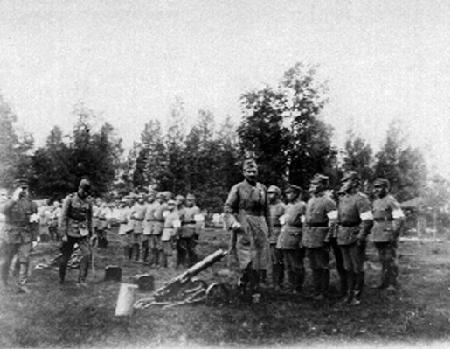


Mannerheim became Commander-in-Chief of the guards, and in February a negotiation board of the Commander-in-Chief was established in the headquarters. This board included representatives from different provincial Civil Guards. After the war the status of the Civil Guards remained undefined, as the Finnish army was organized on a permanent basis. A statute was, however, ratified in August 1918, according to which the Civil Guards could be used to keep order within the country and as military reserves.
When Mannerheim became Regent, he decided to strengthen the Civil Guards in order to improve the safety of the country. These gurads were to be the reserve of the army and the safeguard of the national order. In February 1919 the government strengthened the position of the Civil Guards by a statute, and they were given their own commander-in-chief.
After his term as Regent, Mannerheim was invited to be the honorary chief of the Civil Guards in August 1919. In 1921, when there were disputes over the independence of the Civil Guards from the state, Mannerheim was offered the command of the Civil Guards, but his supporters lost the battle. Lauri Malmberg became Commander-in-Chief, and remained in the post till 1944.
 The so-called
Mäntsälä uprising, which aimed at putting an end to the activities of the communists,
broke out in February 1932. A great number of members of the Civil Guards participated in
the uprising. The determination of President Svinhufvud made the rebels return to their
homes.
The so-called
Mäntsälä uprising, which aimed at putting an end to the activities of the communists,
broke out in February 1932. A great number of members of the Civil Guards participated in
the uprising. The determination of President Svinhufvud made the rebels return to their
homes.
When reforms were made in the defence forces in the 1930s, the Civil Guards were given a more definite task as an institution attending to the military training of the reserve. During the Winter War they became part of the defence forces, and members of the working class organizations were also allowed to join. All suspicions from 1918 were pushed aside. The main staff of the Civil Guards became the Staff of Domestic Troops, and the older members of the Civil Guards attended to the defence of the home regions. In autumn 1940 the Civil Guard districts were assigned the duties of the military districts.
At the end of the Continuation War the Soviet Union demanded that the Civil Guards and their sister organization Lotta Svärd were to be abolished, because the Domestic Troops would have frustrated the Soviet intentions of confining the Finnish army to a minimum, and because the civil guards were thought to prevent the change of the Finnish constitution in the socialist spirit. The Finnish Parliament passed the law on the abolition of the Civil Guards without voting on 3 November, 1944. President Mannerheim ratified the law. In his Order of the Day on 16 November Mannerheim thanked the civil guards for their work for the benefit of the country.
Commander-in-Chief 1918 | Headquarters 1918
| Vaasa Senate | Hannes Ignatius
| Martin Wetzer | Harald Hjalmarson
| Ernst Linder | Gösta Theslöf | Jägers | St Petersburg Question | Relations with Germany | Cross of Liberty
| Eastern Karelia | Uusimaa Dragoon
Regiment | Fir Twig | Finnish Flag
| Swedish Brigade | Civil Guards | Jäger Conflict | Heikki Kekoni | Red Prisoners | Wilhelm Thesleff
| Aarne Sihvo | Rudolf Walden |
Air Force - Air Weapon | Red and White
Terrorism | Great Parade 16 May, 1918 | Åland Question | Monarchy | Mannerheim's Resignation
COURSE OF LIFE | FAMILY | TIME OF GROWTH | MILITARY CAREER | WAR OF INDEPENDENCE | REGENT 1918-1919 | CIVILIAN | DEFENCE COUNCIL | COMMANDER-IN-CHIEF 1939-1946 | PRESIDENT OF THE REPUBLIC 1944-1946 | RETIREMENT | SPECIAL TOPICS | SEARCH